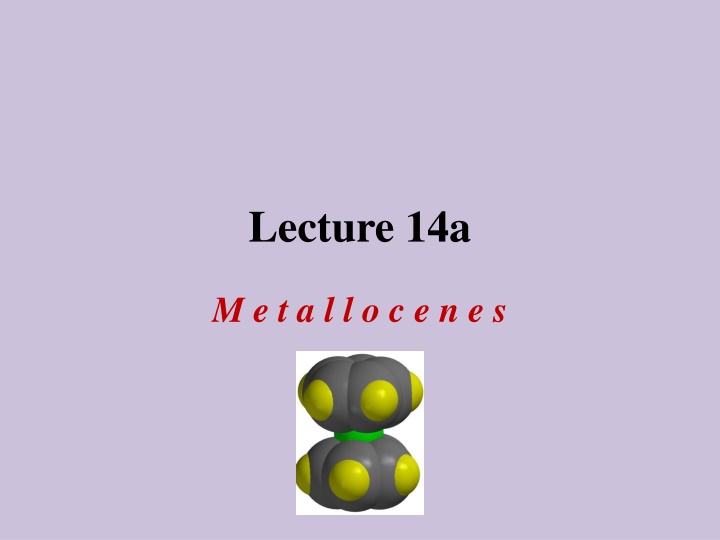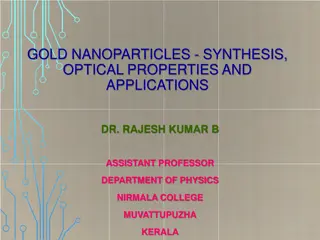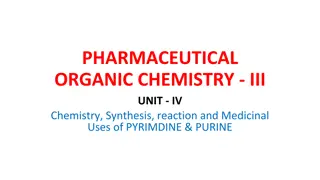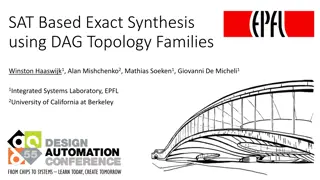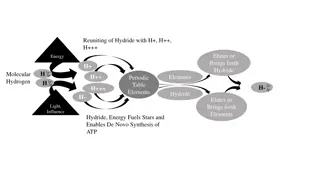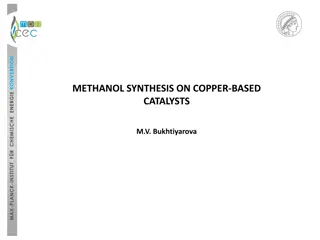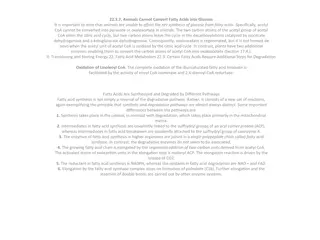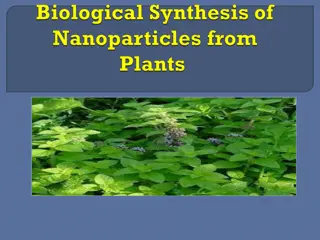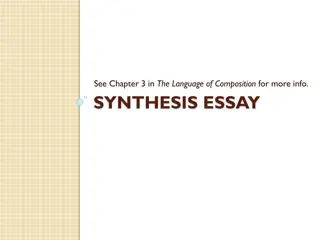MetalloCenes Synthesis and Properties
The synthesis of metalloCenes involving alkali metals, transition metals, and their properties. Discusses reactions, challenges, and acid-base interactions with metal chlorides. Highlights methods to obtain anhydrous metal chlorides and the associated problems. Overall, the content delves into the complex chemistry of metalloCenes synthesis.
Download Presentation

Please find below an Image/Link to download the presentation.
The content on the website is provided AS IS for your information and personal use only. It may not be sold, licensed, or shared on other websites without obtaining consent from the author.If you encounter any issues during the download, it is possible that the publisher has removed the file from their server.
You are allowed to download the files provided on this website for personal or commercial use, subject to the condition that they are used lawfully. All files are the property of their respective owners.
The content on the website is provided AS IS for your information and personal use only. It may not be sold, licensed, or shared on other websites without obtaining consent from the author.
E N D
Presentation Transcript
Lecture 14a M e t a l l o c e n e s
Synthesis I Alkali metal cyclopentadienides (MCp) Alkali metals dissolve in liquid ammonia with a dark blue color at low concentrations (and bronze color at high concentrations) due to solvated electrons that are trapped in a solvent cage (video). The addition of the cyclopentadiene to this solution causes the color of the solution to disappear as soon as the alkali metal is consumed completely (titration). Sodium hydride (NaH) can be used as a base, which leads to the formation of hydrogen as well. Magnesium It is less reactive than sodium or potassium because it often possesses a thick oxide layer (hence the problems to initiate the Grignard reaction) and does not dissolve readily in liquid ammonia from the bulk metal. Its lower reactivity compared to alkali metals demands elevated temperatures (like iron) to react with cyclopentadiene. NH3(l) MC5H5+ 1/2 H2 M + C5H6 M=Li, Na, K 500 oC M + 2 C5H6 M(C5H5)2+ H2 M=Mg, Fe Solvent M(C5H5)2+ 2 NaCl M=V, Cr, Mn, Fe, Co, Ni Solvent= THF, DME, NH3(l) MCl2 + 2 NaC5H5 FeCl2 + C5H6 + 2 Et2NH Fe(C5H5)2+2[Et2NH2]Cl Toluene MCl4 + 2 NaC5H5 M= Ti, Zr (C5H5)2MCl2 + 2 NaCl
Synthesis II Transition metals are generally not reactive enough for the direct reaction except when very high temperatures are used i.e., iron (see original ferrocene synthesis). A metathesis reaction (=double displacement) is often employed: The reaction of an anhydrous metal chloride with an alkali metal cyclopentadienide. The reaction can lead to a complete or a partial exchange depending on the ratio of the metal halide to the alkali metal cyclopentadienide. The choice of solvent determines which of the products precipitates. M + 2 C5H6 NH3(l) M + C5H6 MC5H5+ 1/2 H2 M=Li, Na, K 500 oC M(C5H5)2+ H2 M=Mg, Fe Solvent M(C5H5)2+ 2 NaCl M=V, Cr, Mn, Fe, Co, Ni Solvent= THF, DME, NH3(l) MCl2 + 2 NaC5H5 FeCl2 + C5H6 + 2 Et2NH Fe(C5H5)2+2[Et2NH2]Cl Toluene MCl4 + 2 NaC5H5 M= Ti, Zr (C5H5)2MCl2 + 2 NaCl I
Synthesis III Problem: Most commercial metal chlorides are hydrates, which react with the Cp-anion in an acid-base reaction The acid strength of the aqua ion depends on the metal and its charge. Aqua complex [Fe(H2O)6]2+ [Fe(H2O)6]3+ [Co(H2O)6]2+ [Ni(H2O)6]2+ [Al(H2O)6]3+ [Cr(H2O)6]3+ Ka 3.2*10-10 (~hydrocyanic acid) 6.3*10-3 (~phosphoric acid) 1.3*10-9 (~hypobromous acid) 2.5*10-11(~hypoiodous acid) 1.4*10-5 (~acetic acid) 1.6*10-4 (~formic acid) The smaller the metal ion and the higher its charge, the more acidic the aqua complex is. The average metal ion water molecule distance decreases in these cases, which favors the loss of a proton. All of these aquo complexes have higher Ka-values than CpH itself (Ka=1.0*10-15), which means that they are stronger acids.
Synthesis IV Anhydrous metal chlorides can be obtained from various commercial sources but their quality is often questionable. They can be obtained by direct chlorination of metals at elevated temperatures (~200-1000 oC): The dehydration of metal chloride hydrates with thionyl chloride or dimethyl acetal to consume the water in a chemical reaction. Problems: Accessibility of thionyl chloride (restricted substance because it is heavily used in the illicit drug synthesis i.e., amphetamines). Production of noxious gases (SO2 and HCl) which requires a hood, thus not particularly green. The products are sometimes very difficult to free entirely from SO2 . Anhydrous metal chlorides are often poorly soluble in organic solvents due to their network structures (i.e., NiCl2: 1001 oC)
Synthesis V The hexammine route circumvents the problem of the conversion of the hydrate to the anhydrous form of the metal halide. The reaction of ammonia with the metal hexaaqua complexes affords the hexammine compounds: Color change: dark-red to pink (Co), green to purple (Ni) Advantages A somewhat higher solubility in organic solvents The ammine complexes are less acidic than aqua complexes because ammonia itself is significantly less acidic than water! They introduce an additional driving force for the reaction, the formation of ammonia gas Disadvantage [Co(NH3)6]Cl2 is very air-sensitive because it is a 19 VE system. It changes to [Co(NH3)6]Cl3 (orange) upon exposure to air.
Synthesis VI The synthesis of the metallocene uses the ammine complex: [M(NH3)6]Cl2 + 2 NaCp MCp2 + 2 NaCl + 6 NH3(g) The solvent determines which compound precipitates: THF: the metallocene usually remains in solution, while sodium chloride precipitates DMSO: the metallocene often times precipitates, while sodium chloride remains dissolved The reactions are often accompanied by distinct color changes i.e., CoCp2: dark-brown, NiCp2: dark-green Ammonia gas is released from the reaction mixture, which makes the reaction irreversible and highly entropy driven.
Properties I Alkali metal cyclopentadienides are ionic i.e., LiCp, NaCp, KCp, etc. They are soluble in many polar solvents like THF, DMSO, etc. but they are insoluble in non- polar solvents like hexane, pentane, etc. They react readily with protic solvents like water and alcohols (in some cases very violently). Many of them react with chlorinated solvents as well because of their redox properties. 138o KCp LiCp, NaCp
Properties II Many divalent transition metals form sandwich complexes i.e., ferrocene, cobaltocene, nickelocene, etc. These compounds are non-polar if they possess a sandwich structure but become increasingly more polar if the Cp-rings become tilted with respect to each other i.e., Cp2Sn. The M-C bond distances differ with the number of total valence electrons SnCp2 Valence Electrons Fe Co Ni 17 FeCp2+ (207 pm) FeCp2 (204 pm) 148o 18 CoCp2+ (203 pm) CoCp2 (210 pm) 19 NiCp2+ (206 pm) NiCp2 (210 pm) 20 They are often soluble in non-polar or low polarity solvents like hexane, pentane, diethyl ether, dichloromethane, etc. but are usually poorly soluble in polar solvents. Their reactivity towards chlorinated solvents varies greatly because of their redox properties. Many of the sandwich complexes can also be sublimed because they are non-polar. i.e., ferrocene can be sublimed at ~80 oC in vacuo.
Properties III Cobaltocene is a strong reducing reagent (E0= -1.33 V vs. FeCp2). because it is a 19 valence electron system with its highest electron in an anti-bonding orbital. The oxidation with iodine leads to the light-green cobaltocenium ion: It is often used as counter ion to crystallize large anions (158 hits in the Cambridge database). The reducing power can be increased by substitution on the Cp-ring with electron-donating groups that raise the energy of the anti-bonding orbitals i.e., Co(CpMe5)2: (E0= -1.94 V vs. FeCp2). Placing electron-accepting groups on the Cp-ring make the reduction potential more positive i.e., acetylferrocene (E0= 0.24 V vs. FeCp2), cyanoferrocene (E0= 0.36 V vs. FeCp2).
Properties IV HgCp2 can be obtained from aqueous solution The compound is light and heat sensitive. The X-ray structure displays two -bonds between the mercury atom and one carbon atom of each ring. HgCp2 does undergo Diels-Alder reactions as well as aromatic substitution (i.e., coupling with Pd-catalyst). In solution, it only exhibits one signal in the 1H-NMR spectrum because of a fast exchange between different bonding modes ( 1, 5-bonding). A similar mode is found in BeCp2, Zn(CpMe5)2
Applications I Schwartz Reagent: Cp2Zr(H)Cl LiAlH4 Cl Cl Cl Zr + Zr Zr H Cl Br2 O2 D2O D OH Br It reacts with alkenes and alkynes in a hydrozirconation reaction similar (syn addition) to B2H6 Selectivity: terminal alkyne > terminal alkene ~ internal alkyne > disubstituted alkene It is much more chemoselective and easier to handle than B2H6
Applications II Schwartz Reagent: Cp2Zr(H)Cl After the addition to an alkene, carbon monoxide can be inserted into the labile Zr-C bond leading to acyl compounds. Depending on the subsequent workup, various carbonyl compounds can be obtained from there.
Applications III Cyclopentadiene compounds of early transition metals i.e., titanium, zirconium, etc. are Lewis acids because of the incomplete valence shell i.e., Cp2ZrCl2 (16 VE). Due to their Lewis acidity they have been used as catalyst in the Ziegler-Natta reaction (polymerization of ethylene or propylene). Of particular interest for polymerization reactions are ansa-metallocenes because the bridge locks the Cp-rings and also changes the reactivity of the metal center based on X (i.e., CH2, SiMe2). http://upload.wikimedia.org/wikipedia/commons/thumb/0/0e/AnsaMetallocene.png/200px-AnsaMetallocene.png
Applications IV Mechanism of Ziegler-Natta polymerization of ethylene http://www.scielo.br/img/revistas/jbchs/v22n10/a02sche13M.jpg MAO=Methyl alumoxane
Applications V Ferroquine completed clinical test phase Iib in 2011 (antimalarial drug) Ferrocifen garnered a lot of interested as breast cancer treatment
